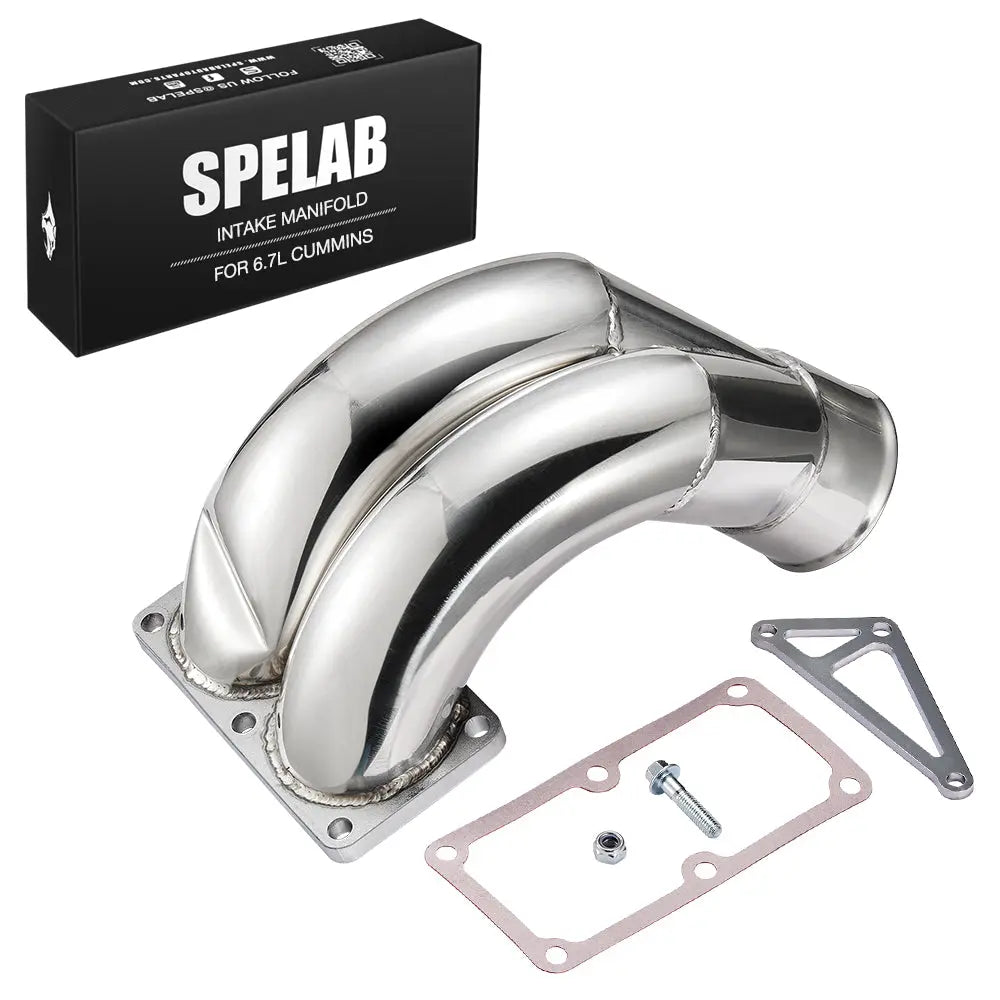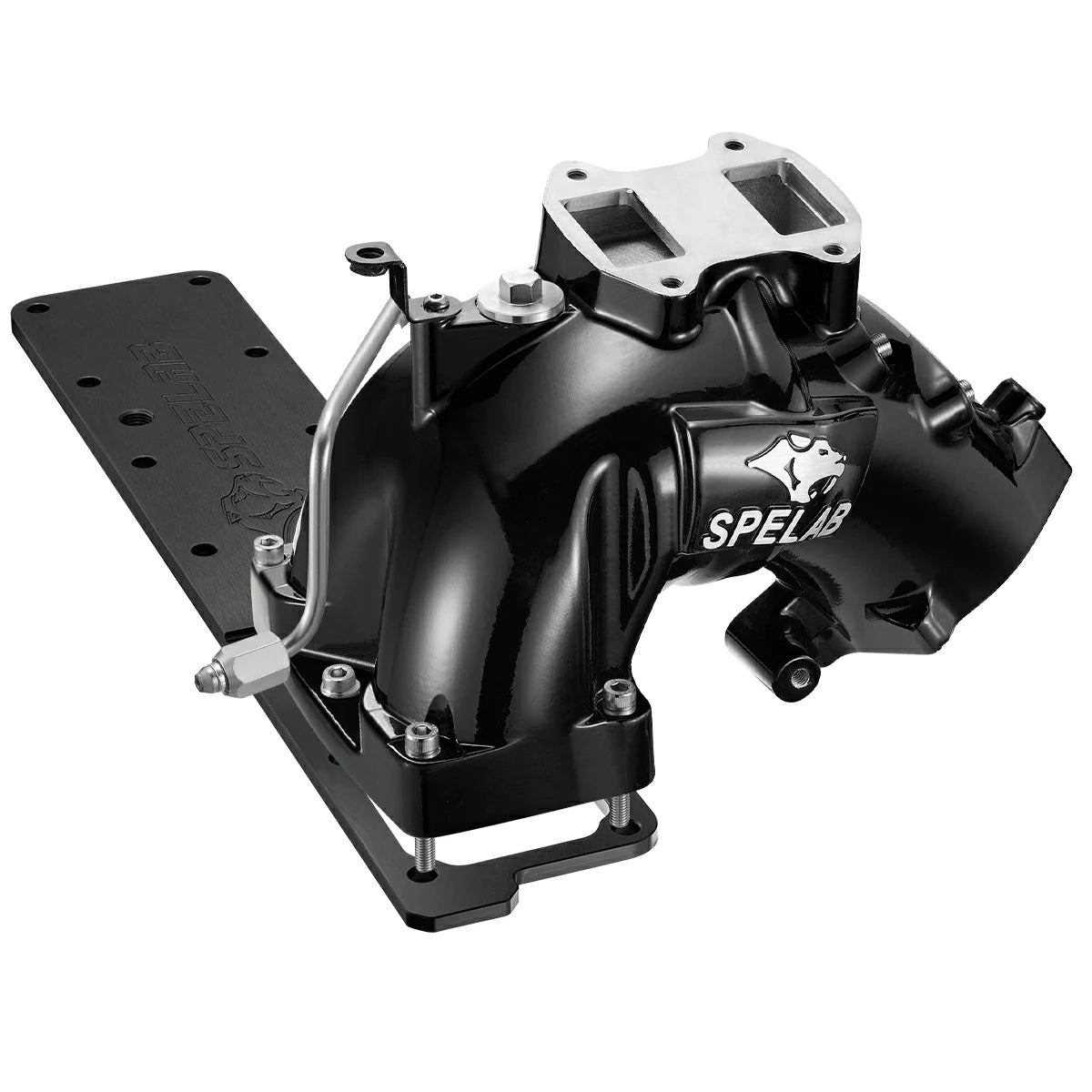Carbon buildup in 6.7L Cummins engines is a common issue, primarily caused by the blockage of the EGR (Exhaust Gas Recirculation) system and the incomplete combustion of recirculated exhaust gases. This buildup restricts airflow and diminishes engine efficiency.
At SPELAB, we offer two intake manifold solutions to improve airflow—although the intake manifold itself does not directly address carbon buildup. The EGR delete kit, however, provides a permanent solution to the carbon buildup problem.
This article will compare the New Intake Manifold, the 3.5'' Budget Intake Manifold, and the OEM (Stock) Manifold, focusing on their airflow capabilities to help you decide which option best suits your needs.
1. Target Audience: 6.7L Cummins Truck Owners
Common Problems Faced by 6.7L Cummins Truck Owners
-
Cause of Carbon Buildup: The primary cause of carbon buildup is the blockage in the EGR system and incomplete combustion of recirculated exhaust gases. This process leads to carbon deposits in the intake manifold and EGR system, restricting airflow and reducing engine performance over time.
-
Solutions: The key to addressing carbon buildup is to:
- Short-term fix (Cleaning the intake and EGR system): Regular cleaning can help maintain airflow but does not resolve the underlying issue.
- Long-term solution (EGR Delete Kit): Installing an EGR delete kit completely eliminates the problem by stopping exhaust gases from being recirculated, preventing future carbon buildup.
2. Solutions: How Each Intake Manifold Addresses Common Problems
While the intake manifold itself does not directly solve the carbon buildup problem, it plays a critical role in airflow improvement. By increasing the CFM (Cubic Feet per Minute) of air entering the engine, it allows for better combustion and higher performance. Pairing the intake manifold with an EGR delete kit offers the best results by both increasing airflow and eliminating the root cause of carbon buildup.
Intake Manifold Role in Airflow
-
CFM Airflow Increase: The intake manifold's primary role is to enhance the amount of air (CFM) entering the engine for better combustion. While it doesn't clean carbon deposits, improved airflow helps the engine operate more efficiently, especially at higher RPMs.
-
Complementary Products:
- EGR Delete Kit: This permanently solves the carbon buildup issue by preventing the recirculation of exhaust gases.
- Grid Heater Delete Plate: This improves airflow by removing restrictions in the intake path, complementing the performance of the intake manifold.

3.5'' Intake Manifold for 6.7L Cummins 2007-2018 Dodge Ram 2500/3500 | SPELAB
Intake Manifold
$99.00
Buy Now
New Intake Manifold: The High-Performance Upgrade
- Key Advantages: For those who demand the best, the New Intake Manifold is the ultimate solution. Priced at $598, this manifold offers an increased airflow capacity—twice the size of the stock manifold—significantly reducing carbon buildup while providing a major horsepower boost. This product is ideal for off-roaders, heavy-duty towing, and performance enthusiasts who require maximum power from their truck.
- Recommended Add-On: For even greater results, we recommend pairing it with the EGR Delete Kit for $109.77. This combination eliminates carbon buildup from exhaust gases and ensures your engine remains clean and efficient for years to come.

Intake Manifold for 6.7L Cummins 2007-2024 Dodge Ram 2500/3500 | SPELAB
Intake Manifold
$598.00
Buy Now
3. Performance Comparison: Budget vs. Upgrade
When choosing between the New Intake Manifold, 3.5'' Budget Intake Manifold, and OEM (Stock) Manifold, it's essential to consider the CFM airflow and MAF (Mass Air Flow). These figures directly impact engine efficiency and power output, helping you understand how much airflow and oxygen each manifold provides for combustion.

Airflow (CFM) Comparison:
- New Intake Manifold: 897 CFM – The highest airflow capacity, allowing for optimal engine performance, especially when combined with an EGR delete kit.
- 3.5'' Budget Intake Manifold: 487 CFM – A significant improvement over stock, providing a budget-friendly performance boost.
- OEM (Stock) Manifold: 421 CFM – The stock manifold has limited airflow, restricting engine performance, especially under heavy loads.
Mass Air Flow (MAF) Comparison (lbs/min):
- New Intake Manifold: 72.7 lbs/min – Delivers the most oxygen for combustion, maximizing horsepower and efficiency.
- 3.5'' Budget Intake Manifold: 43.5 lbs/min – Offers a solid improvement in MAF, providing better performance for daily drivers.
- OEM (Stock) Manifold: 38.6 lbs/min – Provides the least oxygen, limiting your engine’s ability to achieve its full potential.

Conclusion: Choosing the Right Solution for Your 6.7L Cummins
To maximize your 6.7L Cummins engine's performance and address airflow-related issues, your choice of intake manifold is crucial. However, if you're dealing with carbon buildup, it's important to understand that the intake manifold itself will not directly solve the problem—this is where the EGR delete kit comes in.
Key Takeaways:
- For Maximum Airflow and Power: The New Intake Manifold offers the highest CFM and MAF, providing a significant performance boost for those looking to maximize their engine’s efficiency.
- For Budget-Conscious Users: The 3.5'' Budget Intake Manifold delivers a noticeable improvement over stock at a more affordable price point, though it doesn’t match the performance of the New Intake Manifold.
By combining a New Intake Manifold with an EGR delete kit, you can dramatically improve both airflow and engine cleanliness, ensuring long-term reliability and peak performance.
For more information on these products, or to make a purchase, visit the Spelab auto parts or contact our team for expert guidance and support.
FAQs
Q1: What causes carbon buildup in my 6.7L Cummins engine?
A1: Carbon buildup is primarily caused by EGR system blockage and incomplete combustion of recirculated exhaust gases.
Q2: How can I permanently solve carbon buildup in my engine?
A2: Installing an EGR delete kit is the best solution, as it prevents exhaust gases from being recirculated, eliminating carbon buildup at its source.
Q3: Does upgrading the intake manifold help with carbon buildup?
A3: No, upgrading the intake manifold increases airflow (CFM) for better engine performance, but it doesn't directly clean or prevent carbon buildup. Pairing it with an EGR delete kit is ideal.
Q4: What is the difference between CFM and MAF?
A4: CFM (Cubic Feet per Minute) measures the volume of air flowing into the engine, while MAF (Mass Air Flow) measures the weight of the air, both critical for combustion efficiency.
Q5: How does the New Intake Manifold improve engine performance?
A5: The New Intake Manifold delivers significantly more airflow (897 CFM) and mass air flow (72.7 lbs/min), maximizing combustion efficiency and boosting horsepower.
Q6: How does the 3.5'' Budget Intake Manifold compare to the OEM manifold?
A6: The 3.5'' Budget Intake Manifold offers better airflow (487 CFM) and mass air flow (43.5 lbs/min) than the OEM manifold, providing a noticeable performance boost at a lower price.
Q7: Is the EGR delete kit necessary if I upgrade my intake manifold?
A7: While not mandatory, pairing an EGR delete kit with an upgraded intake manifold ensures long-term prevention of carbon buildup and further enhances engine performance.
Q8: Which intake manifold is best for daily driving?
A8: The 3.5'' Budget Intake Manifold is ideal for daily driving, offering a good balance between performance and cost, while still improving airflow and efficiency over stock.
Q9: What are the benefits of using a Grid Heater Delete Plate?
A9: The Grid Heater Delete Plate improves airflow by removing restrictions, enhancing overall engine performance when used with an upgraded intake manifold.
Q10: What performance gains can I expect from the New Intake Manifold?
A10: The New Intake Manifold provides a dramatic increase in airflow and mass air flow, resulting in higher horsepower, better fuel efficiency, and reduced engine stress.







